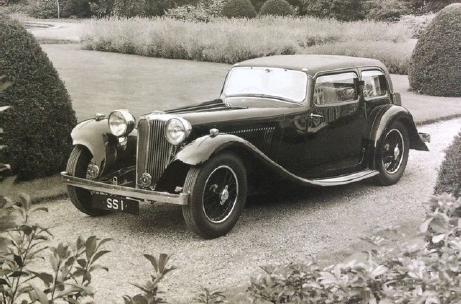
DID – U – KNOW
by Facia Nearside
 In 1929 the Swallow Sidecar and Coachbuilding Company was immensely successful rebodying Austin, Standard, Fiat, and several other brands into elegant and affordable little cars. William Lyons, however, was quick to realize that to move to the next level required more control over the entire process. To achieve his vision, he needed to assemble an automobile to his own specifications. In 1929 the Swallow Sidecar and Coachbuilding Company was immensely successful rebodying Austin, Standard, Fiat, and several other brands into elegant and affordable little cars. William Lyons, however, was quick to realize that to move to the next level required more control over the entire process. To achieve his vision, he needed to assemble an automobile to his own specifications.
 During the late 1920s long bonnets and low roof lines became very fashionable among car stylists. This fact was not lost upon Lyons, but rebodying provided him very little latitude. What he needed was a chassis tailored to fit the desired outcome. Unfortunately, Swallow could neither develop nor make the chassis required. John Black had just become CEO at Standard which was at the time bleeding red ink. Although normally a small series of coach-built cars would not be profitable enough to justify the effort of a separate chassis, Black had confidence in Lyons’ enterprise because of the success of the Standard-Swallow. With very little persuasion he agreed to build an extra low chassis to Lyons’ specifications. Swallow paid £500 to get production underway and agreed to take 500 chassis with a six-cylinder engine and transmission at a price of £130 each. Swallow was finally going to have something technically unique to offer! During the late 1920s long bonnets and low roof lines became very fashionable among car stylists. This fact was not lost upon Lyons, but rebodying provided him very little latitude. What he needed was a chassis tailored to fit the desired outcome. Unfortunately, Swallow could neither develop nor make the chassis required. John Black had just become CEO at Standard which was at the time bleeding red ink. Although normally a small series of coach-built cars would not be profitable enough to justify the effort of a separate chassis, Black had confidence in Lyons’ enterprise because of the success of the Standard-Swallow. With very little persuasion he agreed to build an extra low chassis to Lyons’ specifications. Swallow paid £500 to get production underway and agreed to take 500 chassis with a six-cylinder engine and transmission at a price of £130 each. Swallow was finally going to have something technically unique to offer!

 For this new bespoke product, a new marque name had to be found. Negotiations between Swallow and Standard about whose name would be more prominent eventually ended with a unique compromise. The new marque would be called “SS”, and part of the agreement was not to agree to what the letters stood for and for neither party to reveal a meaning. For this new bespoke product, a new marque name had to be found. Negotiations between Swallow and Standard about whose name would be more prominent eventually ended with a unique compromise. The new marque would be called “SS”, and part of the agreement was not to agree to what the letters stood for and for neither party to reveal a meaning.
 In the fall of 1931, the Swallow Coachbuilding Company (the word Sidecar had been dropped) announced “The SS is Coming”. The SS1 was introduced in October that year and was an immediate sensation at the London Motor Show. It was the first car introduced by the Swallow Coachbuilding Company as a marque in its own right. In the fall of 1931, the Swallow Coachbuilding Company (the word Sidecar had been dropped) announced “The SS is Coming”. The SS1 was introduced in October that year and was an immediate sensation at the London Motor Show. It was the first car introduced by the Swallow Coachbuilding Company as a marque in its own right.
 The slightly smaller four-cylinder SS2 was introduced shortly thereafter. Complaints about the rear passenger space of the SS1 being cramped led to an almost immediate redesign. By September 1932 the car was built on a new more rigid chassis with the rear axle underslung and a longer wheelbase. The proportions were now more attractive and passenger space became quite adequate. Demand for the SS cars grew exponentially leaving Swallow in the enviable position of finding it difficult to produce them fast enough. This was even more significant considering the depressing financial conditions of the early 30s which left many other manufacturers stumbling. Despite this unqualified success however, one final piece of the puzzle remained to be solved. Performance or lack thereof! The slightly smaller four-cylinder SS2 was introduced shortly thereafter. Complaints about the rear passenger space of the SS1 being cramped led to an almost immediate redesign. By September 1932 the car was built on a new more rigid chassis with the rear axle underslung and a longer wheelbase. The proportions were now more attractive and passenger space became quite adequate. Demand for the SS cars grew exponentially leaving Swallow in the enviable position of finding it difficult to produce them fast enough. This was even more significant considering the depressing financial conditions of the early 30s which left many other manufacturers stumbling. Despite this unqualified success however, one final piece of the puzzle remained to be solved. Performance or lack thereof!
 To be continued… To be continued…
Editor Note: Article previously published in British Boots and Bonnets newsletter, June 2022
|